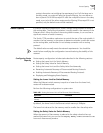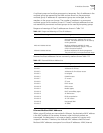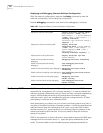
112 CHAPTER 6: MULTICAST PROTOCOL
Assigned Number Authority) stipulates that the higher 24 bits of the multicast
MAC address is 0x01005e and the lower 23 bits of the MAC address is the lower
23 bits of the multicast IP address.
Figure 27 Mapping Between the Multicast IP Address and the Ethernet MAC Address
Only 23 bits of the last 28 bits in the IP multicast address is mapped to the MAC
address. Therefore the 32 IP multicast addresses are mapped to the same MAC
address.
IP Multicast Protocols Multicast uses the multicast group management protocol, and the multicast
routing protocol. The multicast group management protocol uses Internet Group
Management Protocol (IGMP) as the IP multicast basic signaling protocol. It is used
between hosts and routers and enables routers to determine if members of the
multicast group are on the network segment. The multicast routing protocol is
used between multicast routers and creates and maintains multicast routes, and
allows high-efficient multicast packet forwarding. At present, multicast routing
protocols mainly include PIM-SM, PIM-DM.
Tasks for configuring IP Multicast Protocols are described in the following sections:
■ Internet Group Management Protocol (IGMP)
■ Multicast Routing Protocol
Internet Group Management Protocol (IGMP)
Internet Group Management Protocol (IGMP) is the only protocol that hosts can
use. It defines the membership establishment and maintenance mechanism
between hosts and routers, and is the basis of the entire IP multicast. Hosts report
the group membership to a router through IGMP and inform the router of the
conditions of other members in the group through the directly connected host.
If a user on the network joins a multicast group through IGMP declaration, the
multicast router on the network will transmit the information sent to the multicast
group through the multicast routing protocol. Finally, the network will be added to
the multicast tree as a branch. When the host, as a member of a multicast group,
begins receiving the information, the router queries the group periodically to
check whether members in the group are involved. As long as one host is involved,
the router receives data. When all users on the network quit the multicast group,
the related branches are removed from the multicast tree.
Multicast Routing Protocol
A multicast group address has a virtual address. Unicast allows packets to be
routed from the data source to the specified destination address. This is not
possible for multicast. The multicast application sends the packets to a group of
receivers (as with multicast addresses) who are ready to receive the data but not
only to one receiver (as with unicast address).
48-bit MAC
address
32-bit IP
address
5 bits
not
mapped
Lower 23 bits directly mapped


















